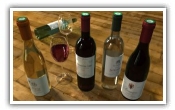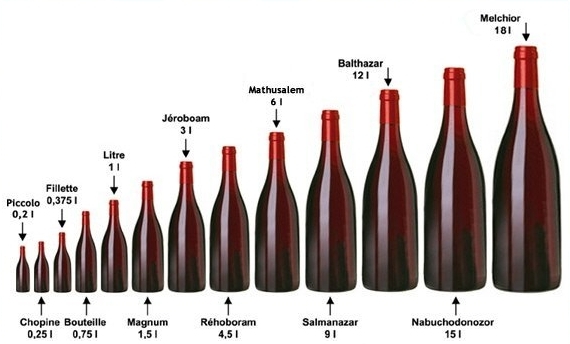The wine bottles: shape and capacity

Capacity
The international standard bottle holds 75 cl (or 750 ml). Most of the wine sold in the world is
bottled in this format, or one of its multiple. The litter bottle is generally used for ordinary wines.
The half bottle that contains 37.5 cl is very successful in restaurants.
Nowadays 50 centilitres bottles are also available but their distribution remains limited.
Multiples of the standard bottles are all named after the Bible

Champagne bottles
| Name of the bottle | Official capacity | 75 cl bottle equivalent |
|---|---|---|
| Piccolo | 20 cl | ± 1/4 bottle |
| Chopine | 25 cl | 1/3 bottle |
| Half, Demi or Fillette | 37,5 cl | 1/2 bottle |
| Bottle or Champenoise | 75 cl | 1 bottle |
| Magnum | 1,5 l | 2 bottles |
| Jeroboam | 3 l | 4 bottles |
| Rehoboam | 4,5 l | 6 bottles |
| Methuselah | 6 l | 8 bottles |
| Salmanazar | 9 l | 12 bottles |
| Balthazar | 12 l | 16 bottles |
| Nebuchadnezzar | 15 l | 20 bottles |
| Melchior | 18 l | 24 bottles |
Bordeaux bottles
| Name of the bottle | Official capacity | 75 cl bottle equivalent |
|---|---|---|
| Half, Demi or Fillette | 37,5 cl | 1/2 bottle |
| Bottle | 75 cl | 1 bottle |
| Magnum | 1,5 l | 2 bottles |
| Marie-Jeanne | 2,5 l | 3 bottles |
| Double Magnum | 3 l | 4 bottles |
| Jeroboam | 4,5 l | 6 bottles |
| Imperial | 6 l | 8 bottles |
Port bottles
| Name of the bottle | Official capacity | 75 cl bottle equivalent |
|---|---|---|
| Bottle | 75 cl | 1 bottle |
| Magnum | 1,5 l | 2 bottles |
| Tappit-Hen | 3 l | 4 bottles |
| Jeroboam | 3 l | 4 bottles |
The origin of the names given to bottles
Magnum
The Latin word Magnum stands for greatness and magnificence.
Jeroboam
First king of the kingdom of Israel (930-910 BC.). After Solomon’s death, he was proclaimed king by the 10 northern tribes that had revolted against Roboam. To the Hebrew political schism, he added a religious schism by choosing Dan and Bethel as cult venues.
Rehoboam
King of Juda (v. 930-v. 915) and son of Solomon, his tyrannical government ruling created the schism of the ten northern tribes that founded the kingdom of Israel. He kept dominating the two tribes of Juda and Benjamin.
Methuselah
According to the Bible, patriarch son of Enoch and grandfather of Noe. He would have lived 969 years.
Salmanazar
Name of five sovereigns of Assyria. The most important is Salmanazar The Third.
Balthazar
One of the three Magi. King of Arabia, according to St. Matthew (II, 1-12), he followed the bright star that led him to the cave of Bethlehem to worship the child-King Jesus.
Melchior
One of the three Magi. King of Persia, according to St. Matthew (II, 1-12), he followed the bright star that led him to the cave of Bethlehem to worship the child-King Jesus.
Nebuchadnezzar
King of Babylon (Nebuchadnezzar II) (from 605 to 562 BC.). He conquered Syria and Palestine in 604. He seized Jerusalem several times (between 605 and 587), and deported the Jewish population (Babylon’s captivity, 586-538), and submitted Tyr in 573.
The different shapes of bottles
The bottle becomes common as early as the 18th century. Bottle usage considerably increased once it was realised that wine was better preserved in bottle rather than jugs or on the dregs.

The Burgundian
With its reducing shoulders and its bellied look, it is globally spread. Almost all great white and red wines from Burgundy use the “dead leaf” bottle.
The Ligérienne
A variant of the Burgundian, the "Muscadet" is more elegant and finer with the name of the Named Controlled origin engraved at the bottom. The “Anjou”, sometimes engraved with the regional arms, has multiple variants depending on the wine maker or trader.
The Provencal
For the Côtes de Provence, the "flute with corset" for the wine makers and the "cote de Provence" for traders. Many variants exist.
The Champenoise
The champenoise is the most widely used bottle. Some brands still use the 18th century shape of bottle.
The Rhôdanienne
The "rhôdanienne" bear the Côtes du Rhône engraving on its shoulder. When it is bottled in its area of production, the Chateauneuf du Pape is entitled to a bottle embossed with the pontifical seal.
The Alsatian Flute
The Alsatian Flute is the only bottle that is protected by a decree since 1955.
The clavelin
Specific to the Jura, the 62 centilitres clavelin represents what is left of a litter of yellow wine after 6 years in a barrel.
The Bordelaise
Originally the Bordelaise was conical. It became cylindrical to strengthen it and make it easier to manufacture.
A southerner bottle that is also called “frontignan” in Bordeaux. It is available worldwide.
Some vintages and traders use an older version, even or a bottle engraved with a shield.



 Regions of France
Regions of France Regions of Spain
Regions of Spain Regions and areas from the world
Regions and areas from the world